We don’t just talk about marketing. We do it.
Our content marketing agency produces over 300+ articles/month. We research, plan, and produce high-quality content that drives backlinks, authority, and conversions for the web’s biggest brands.
In the past few weeks, we spent $4,008.13 on content promotion, testing how our new custom image and video services significantly improve content performance.
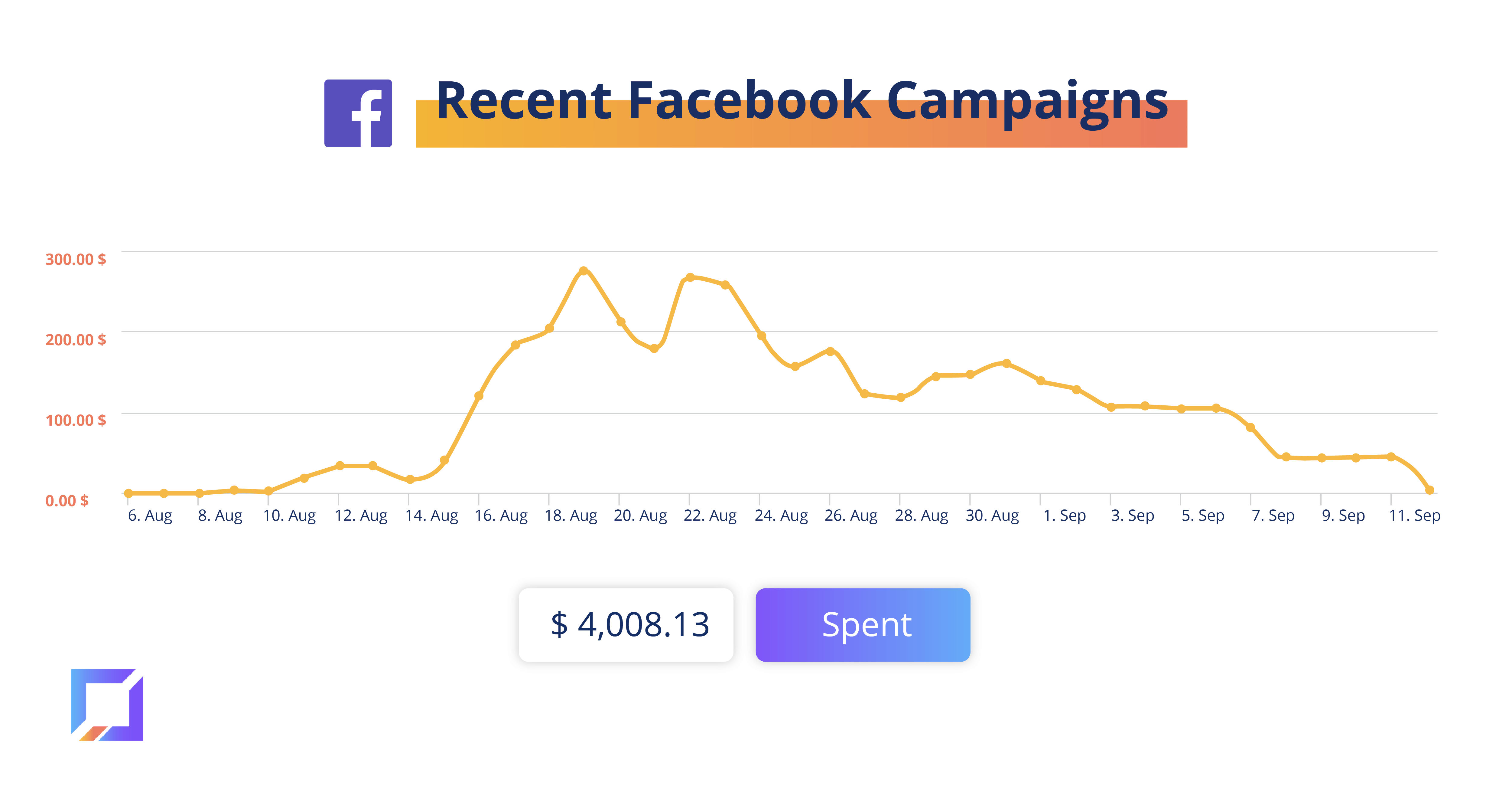
The goal was to put our money where our mouth is and prove that better content not only drives more traffic and leads, but also can decrease promotional costs, too.
I’m going to show you countless ways to bring down costs and increase performance in this post.
➊ Optimizing for relevance score & CTR drops costs.
➋ Think of audience building as an investment in future sales.
➌ Reach vs. frequency – automatically promote posts for engagement, not clicks.
➍ Prioritize placements by funnel stage and ad type to optimize spend.
➎ Routinely split test (not A/B test) ad creatives to scale results.
But first, you’re going to discover why we’re talking about promoted content in the first place, instead of other ‘free’ organic alternatives.
Get long-term ROI.

Social is now pay to play. You just gotta deal.
Remember like-gating?
Stick the discount on a Facebook page tab (yes, those were a thing), and funnel people to like your page to get their hands on the goods.
Sounds stupid. But it worked brilliantly. Until it didn’t. Discount promotion and coupon marketing is now a lot more complex.
How things have changed since then.
Like gates didn’t last long. They were the single-best way to build an audience. Brands rushed headfirst, building out massive audiences like AOL brand pages back in the day.
Every miserable graph looks about the same. Marketers are seeing 50% year-over-year drops in their ability to reach their own people. The ones they worked tirelessly to attract. And paid handsomely to generate.
Zoom out over the course of a few years and the obvious becomes apparent:

Of course, this ain’t anything new.
Organic reach has been steadily declining for at least the past ~five years. It’s one of the major reasons people are leaving for other platforms like TikTok and Instagram.
Unsurprisingly, while Facebook’s organic reach continues to fall off a cliff, another stat continues to climb up and to the right.
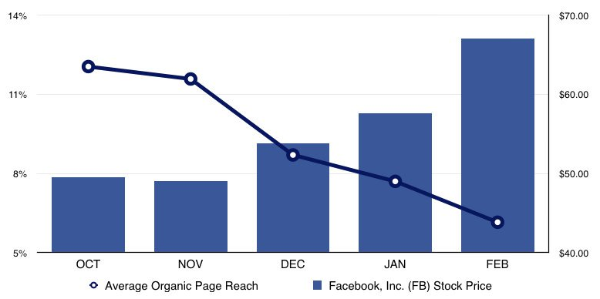
As organic reach nose dives, Facebook’s stock price (buoyed by growing ad spend) lifts in the other direction.
Hmmm… 🤔
Don’t look now, but the same thing is happening on Instagram, too.
The writing’s on the wall. Any ‘free’ platform can (and eventually will) go the way of Facebook when quarterly earnings are due.
The message is clear if you want to distribute content at scale today:
You gotta pay to play.
Period. End of story.
The reason why most people pay for MasterClass is because the quality and the value they get for that money is worth every penny.
Plus, Facebook’s your only viable option for promoted content at scale in most cases, anyway. There’s no better size, with better targeting, for less.
Sure. There are LinkedIn ads. Which are expensive. And shitty.
There are Twitter ads. Which are also shitty. And ironically don’t like when you tweet words like “shitty.” 👇

So where else you gonna turn?
What else you gonna do when you aren’t blessed with VC pipe dreams or connections with journalists or a big Nike logo behind your back?
AdWords is dope. And waaaaaaaaayyyy too expensive for TOFU/MOFU campaigns.
BOFU? Have at it. Nothing better for lead gen.
Facebook ads don’t convert like AdWords. Never have, never will.
But not if you’re trying to get the word out. Not if you’re trying to develop the awareness and interest it takes to scale a business.
AdWords is even a bad match when your customer LTV is stretched out too far. Companies with low average order values, or SaaS ones that only charge a few bucks a month, will take too long to break even.
Sure, you might eventually get back into the black with repurchases, upsells, or 12+ month retention. But otherwise, the highly-competitive CPCs (and low volume of alternative ‘money’ keywords) will put you in a tough spot.
Worst case, you run out of money.
Best case, you’re kinda sorta within touching distance of breaking even.
But you’re not actually making enough on each sale to re-energize that ever-dwindling ad budget. Which means you need millions and millions in the bank to fund growth for years, and then a fast exit strategy to deliver new funding to absorb the expenses (see: Groupon).
Most other companies need scale for less. They need to reach more people for the fewest dollars possible in order to later convert those people at a lower overall cost of acquisition.
It might not happen as quickly or easily as using AdWords. But it’s more reliably sustainable.
And it all starts with building out the widest top of the funnel audience for as little as possible.
That’s what this post is about.
How do you reach the most people for less, earlier in the buying process, to develop enough awareness and familiarity to decrease your costs of acquisition as much as possible?
Using content + Facebook ads.
Let’s get started.
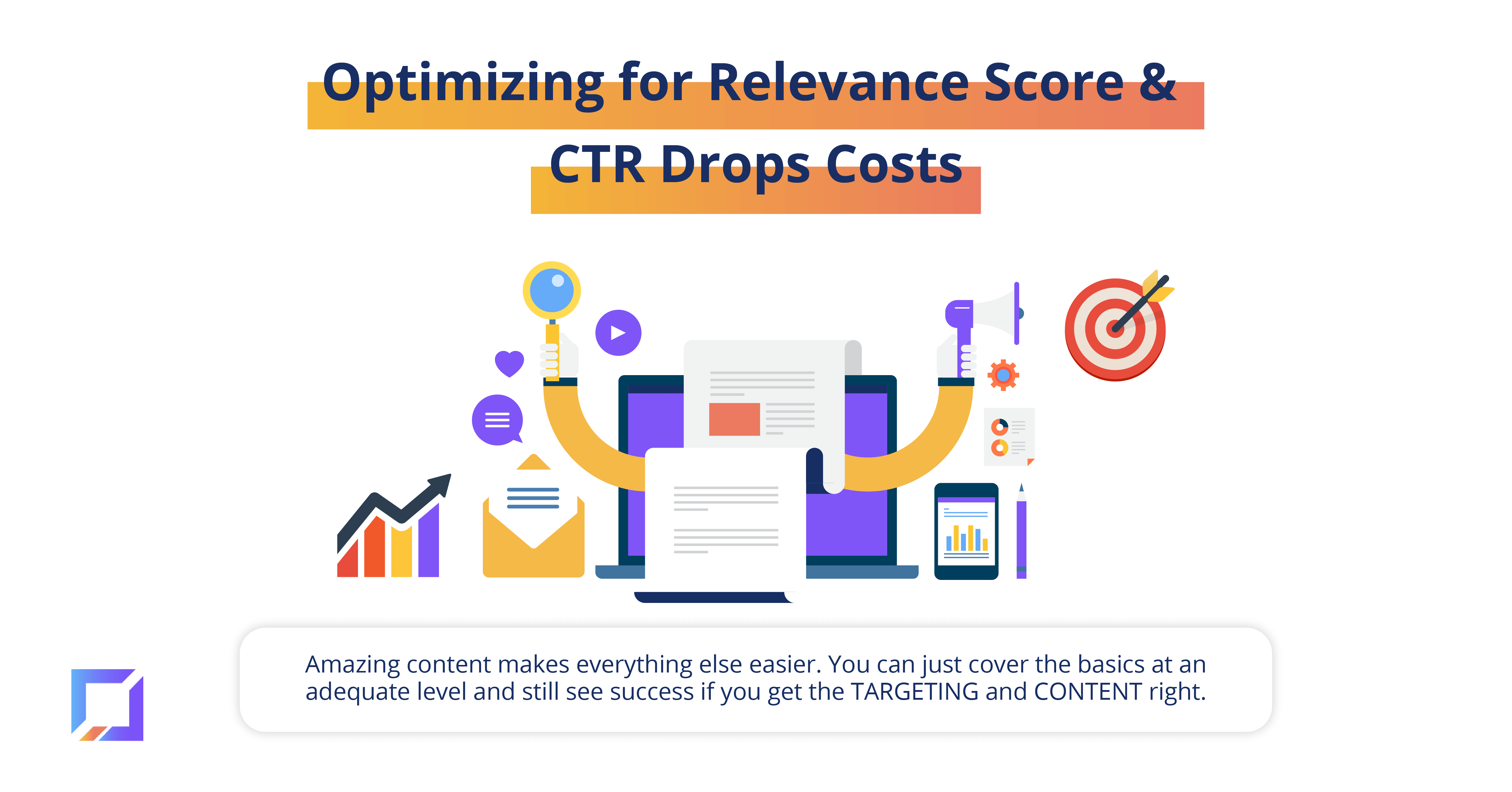
1. Optimizing for relevance score & CTR drops costs.
This tweet recently caught my eye:
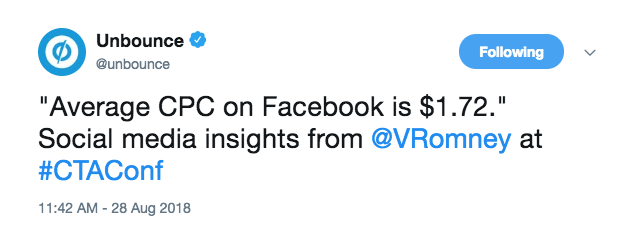
I’m sure it’s legit. The data is probably accurate.
But if true, it means you’re F-d.
A buck seventy two doesn’t sound bad next to AdWords’ insanely-high CPCs. I’ve personally seen AdWords campaigns in insurance and law that range from $30-100/click.
Competitive spaces like car insurance or tv packages are even higher.
However, Facebook don’t work like that. You’ll go broke like that. So don’t succumb to that.
Instead, you need a Facebook sales funnel that generates clicks for a whole helluva lot less.
How?
In a word: Relevance.
Facebook’s Relevance Score works eerily similar to the AdWords Quality Score. It approximates how well your ad will perform based on how likely an audience is to appreciate it.
✅ And — more importantly — it dictates how many people they’ll allow you to reach and for what cost (prioritizing or de-prioritizing your ads proportionately).
Example:
My peeps at AdEspresso ran this test years ago, showing how the relevance score changes from ‘bad’ audience targeting:

To ‘good’ audience targeting:

And how it dropped their CPC from over a buck to only a few cents.
The ‘bad’ audience was a cold, saved one built from a bunch of random interests (like page likes, etc.). The ‘good’ one was a custom audience of sites visits.
From Aaron Agius via Unbounce:
“Achieving a high score decreases your cost per click (CPC) and ensures your ads are delivered to your target audience — ahead of competitors with a lower relevance score.”
This lesson is even more important with TOFU content audiences because most fall into that trap of relying on haphazardly-compiled interests.
Why?
‘Cause you’re not able to use custom audiences as much. You should. But you’re not always able.
Take B2B companies. They don’t often have as much site traffic as B2C ones. Don’t need to. But that puts them at a massive disadvantage when it comes time to distribute content.
✅ So a simple workaround is to (1) upload your small-ish custom lists of leads and customers, plus (2) your site visits, and then create lookalike audiences from both, so that your initial audience numbers at least a couple million.
Otherwise? You’re going to overpay for crap.
Here’s an example.
We ran the same exact campaign, with the same exact ads, to different audiences (a cold, saved one vs. the lookalike option we just explained):
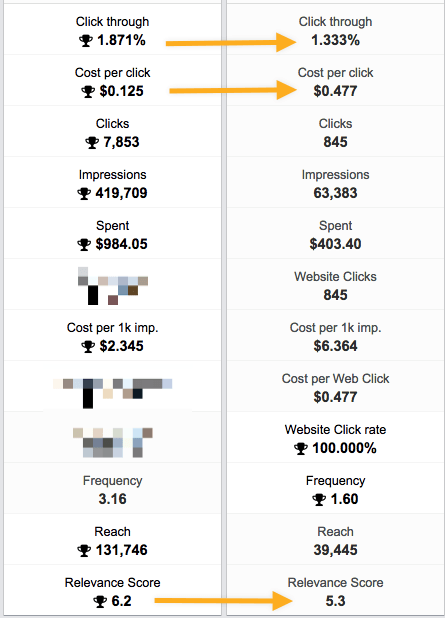
✓ The CTR is better,
✓ And the CPC is lower, because
✓ The Relevance Score is better.
Beyond audience targeting, how else do you lift the relevance score and thus drop campaign CPC?
Better content.
No, not headlines. Not image asset. And not the CTA.
Those things are important. But in our experience (and tests), better content is the underlying Achilles’ Heel in these campaigns.
Amazing content makes everything else easier. The headline hook is simple. Even the image becomes almost irrelevant.
Here’s proof.
We spent almost $1,000 on a single TOFU campaign, generating clicks for around ten cents.

And guess what? The ads themselves were terrible.
We just used the standard featured blog post images, for example, even though we knew these underperformed other options (as I’ll show you later below). We also just Command C’d + Command V’d the headline.
And yet?
The Relevance Score for these ads was solidly over 6.2. For a simple promoted content piece targeting a mostly cold audience who’d never heard of us before.
All those Facebook ad ‘best practices’ are important.
But they don’t matter if you screw this part up.
Because, as you can see here, you can just cover the basics at an adequate level and still see success if you get the (1) targeting and (2) content right.

2. Think of audience building as an investment in future sales.
I’m not the sharpest tool in the shed.
But I’ve always wanted to write an article that goes along the lines of, “You’re not as good a marketer as your brand is.”
The point is that you can stick any mediocre Joe-Schmo marketer into an institution like HubSpot and they’ll succeed. Why? ‘Cause inbound marketing. ‘Cause hundreds of millions in VC money + super smart people + scale + over a decade of brand building.
As a result? Almost any campaign they run will be wildly successful.
That’s not a knock. It’s completely deserved on their part. But it’s reality.
This is something small / new companies don’t get. And big ones take for granted — they’re used to everyone saying “yes” to their ideas.
The problem is that the vast majority of companies, like 99.9999999999%, will never be anywhere close to HubSpot — despite what ‘business journalists’ (heavy on the air quotes) — lead you to believe by only writing about stories at the extremes.
What does this rant have to do with content promotion?
✅ Your first few thousand dollars spent on content promotion will be purely audience building if you don’t already have a lot of site visits.
It’s an investment. One that might take months to pay off. (If at all.)
The problem is when marketers get short-sighted. They get greedy or rushed. And this is why bad marketers exclaim “Facebook ads don’t work.” Like that time GM infamously pulled their million-dollar Facebook ad budget… only to slink back 11 months later with their tail between their legs.
(You know what’s a better marketing strategy, GM? Not killing people.)
When you try to build a Facebook audience too cheaply — getting likes for a few cents or targeting peeps in third-world countries — you’re only sabotaging future campaign success.
✅ Your TOFU content views, ad engagements, and site visits create a pool of people that you can later tap to sell your crap. If the people in that pool are unqualified, you won’t sell any crap.
We just illustrated that in the last point. And covered it in a previous content marketing case study.
But here’s another example to completely beat a dead horse.
Same ads and content, different audiences, leads to 70% cost savings ($0.17 CPC vs. the other at $0.57).
Plus another one, where we’re continuing to send TOFU content to audiences we’ve prebuilt (vs. the alternative of going after more cold people).
Campaign A is a cold, saved audience made up off interests, while B is based on previous engagements.
A better click-through rate and cost per click. Also, more post engagements for a better rate.
A couple cents here or there doesn’t sound like much. But it does when you’re investing (and prioritizing) audience building to make future promoted content easier (read: less expensive).
For example, we’ve been creating short ‘video commercials’ for content distribution for the sole purpose of building out a targeted audience for as little as possible.
And we’ve been able to get results (e.g. views) for as little as a penny.
Plus, it scales.
Ad fatigue affects all Facebook campaigns. Ones that worked like gangbusters weeks ago start to fade. CTR drops off. Frequency creeps up. And as a result, your CPC starts skyrocketing.
But we’ve seen audience building with videos scale effectively, without succumbing to the same fatigue problem.
If you’re paying attention to the fine print, you might have a counterargument.
We’re using a two-second continuous view. Because we’re intentionally keeping the video as short as possible.
Which means a healthy percentage (86.64% to be exact) are viewing for at least 25%.

So… is it even a question?
Here’s how it all comes full circle.
You want to build out an audience of 10,000. Not huge but not insignificant. This is the spread you’d be looking at based on the cost ranges (~$1.50 to $0.01) we’ve looked at so far.
A video that might cost a few hundred bucks to produce has the potential to save you a few thousand bucks. Not a bad ROI on content.
Plus, you’re not diluting audience quality to artificially drive these costs down, either.
The issue? It’s gonna take you a few thousands bucks and weeks to simply get in the game.
But if you’re patient, and start big enough to begin with, the results (leads & sales) will be there in the months to follow.
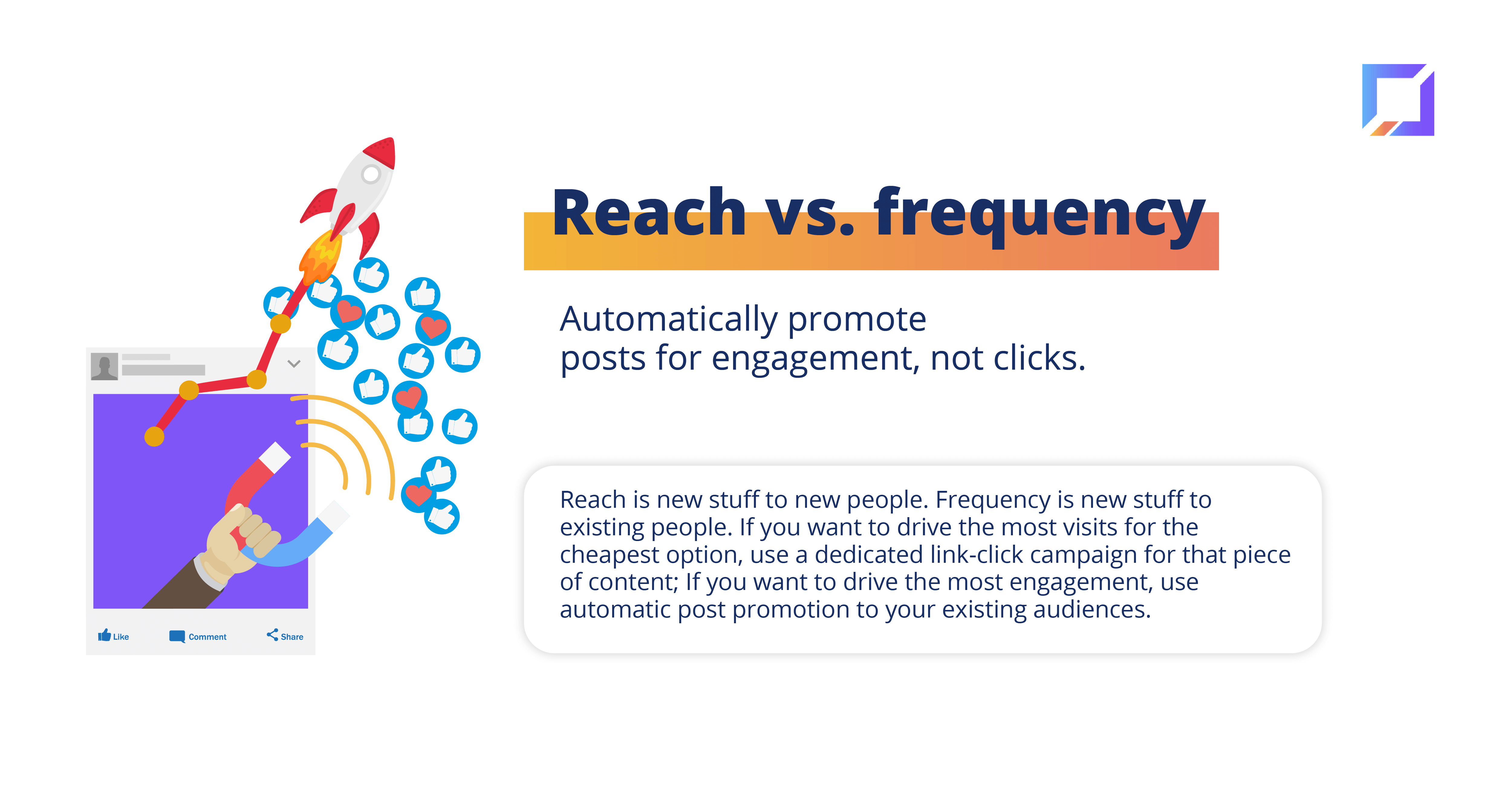
3. Reach vs. frequency – Automatically promote posts for engagement, not clicks.
Reach & frequency date back to the 1960s. We’re talking classic advertising 101. Ogilvy in the good ol’ days.
Reach is new stuff to new people. Frequency is new stuff to existing people.
Each metric can be found on Facebook ad campaigns. But how they’re technically used render them too small and narrow to be helpful.
Like, the “Frequency” of a single ad campaign is mostly useless. It can contribute to ad fatigue, but if you’re testing and rotating creative (also assuming good audience + good content), you largely don’t have to worry about it.
However, it’s when you zoom out to get a wider perspective and look at it from a better vantage point that the mistakes become obvious.
The actual campaigns and objectives you select can (and do) influence performance.
Let’s say you’re going to promote a brand new post.
The default campaign optimization, impressions, may not result in the desired action. It depends on what you’re shooting for: Reach or frequency.
If you’re optimizing for reach, you’d want to optimize for the lowest link clicks to drive the most visits.
Optimizing for impressions isn’t bad per se. It just depends on your objectives.
Similarly, the entire campaign you select hinges on this decision, too.
✅ We found better results optimizing for reach with dedicated content campaigns vs. optimizing for frequency with automatic post promotion.
That means:
- If you want to drive the most visits for the cheapest option, use a dedicated link-click campaign for that piece of content.
- If you want to drive the most engagement, use automatic post promotion to your existing audiences.
And here’s the data below to show what we’re talking about.
Campaign A is a simple automatic post promotion campaign that automatically promotes the latest content we publish to existing audiences. Notice the comparatively lower CTR, much higher CPC, but WAY higher post engagement than Campaign B (which is trying to drive new visits).
Here’s an in-depth look at the individual performance of all content promoted under Campaign A.
As you can see, clicks are low. That’d be bad if we were trying to optimize for site visits in this case (reach). But we’re not, we’re looking at engagement (frequency). So it’s cool.
Post promotion campaigns work well when targeting the existing audience. You’re optimizing for frequency, and cementing your brand in the mind of customers.
But don’t expect them to drive the reach-based vanity metrics we all know, love, and quote — like visits or clicks.
You’re better off designing dedicated campaigns that optimize for the lowest link clicks for that.
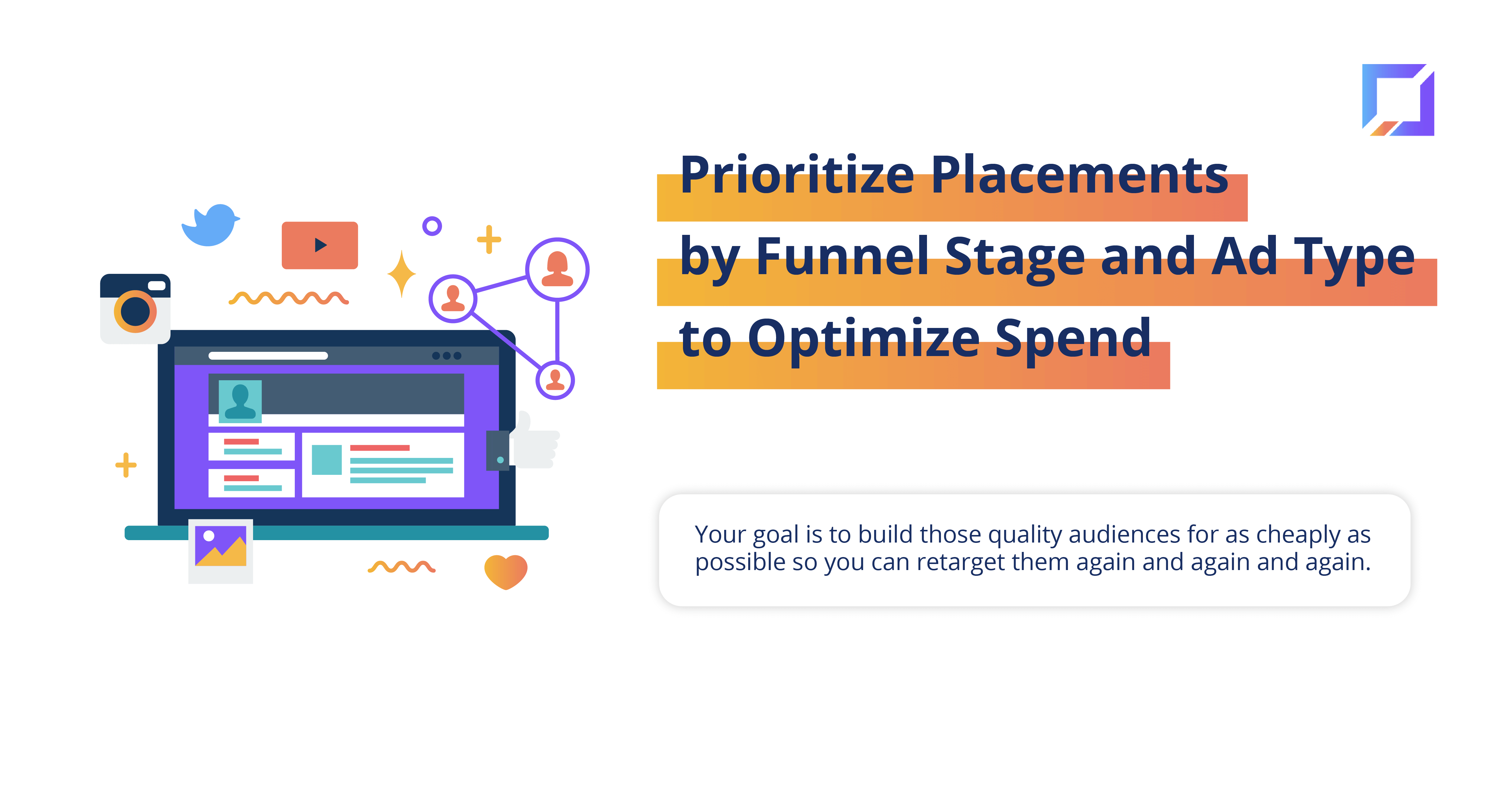
4. Prioritize placements by funnel stage and ad type to optimize spend.
Ok, let’s skip straight to the chase on this one.
You have four broad placement options with Facebook ads:
- Mobile + Messenger
- Mobile + Audience Network
- Instagram ads
- Desktop and Right Column
✅ All TOFU/MOFU promoted content campaigns should run on the first three (primarily) mobile placements.
Again, if we’re optimizing for (1) cheap, yet qualified clicks, and (2) cheap engagements from existing audiences, mobile placements are almost always going to be more cost-effective than Desktop and Right Column ones.
Otherwise, you risk overpaying for market conditions — not actual ROI.
Here are a few examples to illustrate this point.
The first content campaign comes from our old post relaunch case study. CTR was highest, and CPC lowest, on the three mobile-based placements.
But here’s an even more skewed view.
The top line in purple shows the CPC for Desktop + Right Column placement. Notice how it’s all the way at the top by itself?
Yeah, that’s not good.
The following three lines below are all mobile-based. And all significantly less expensive.
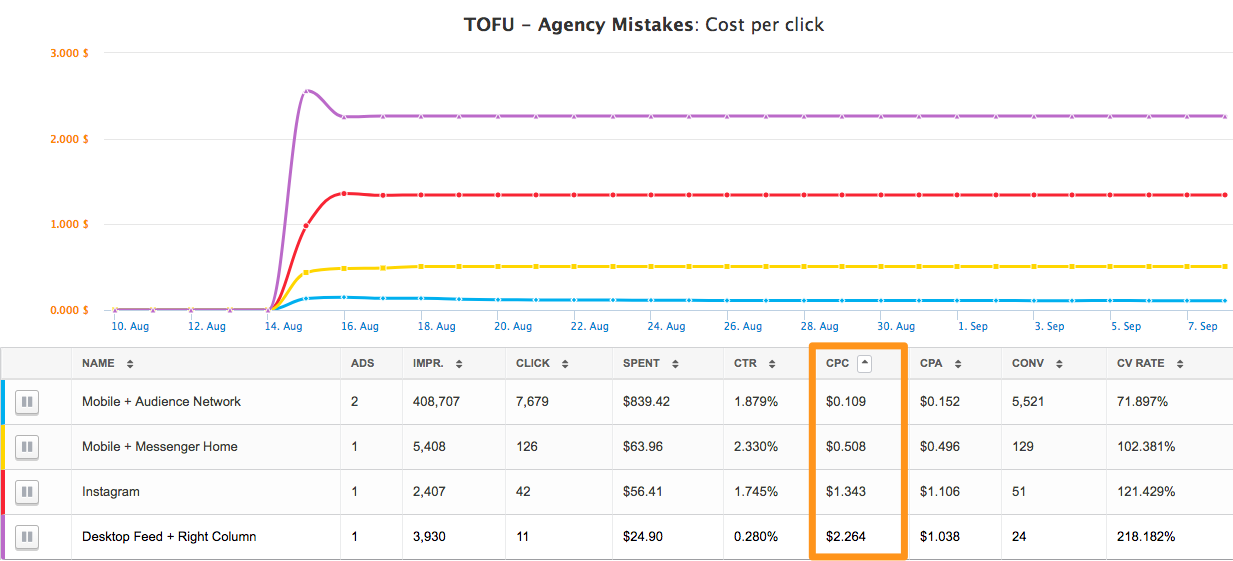
Now, let’s make this even more dramatic.
We spent a total of $984.69 on that one campaign.
Let’s see how many visits you can drive on each placement if you spent that entire budget at these rates.
Take the amount spent on that one campaign, multiplied by the CPC of each placement, to see what the difference in clicks would be.
A few dozen cents add up at scale. To the tune of nearly 2,000%.
Here is the same exact campaign (objectives, ad creative, and placement options), except this time, with a different audience (a cold, saved one vs. lookalikes).
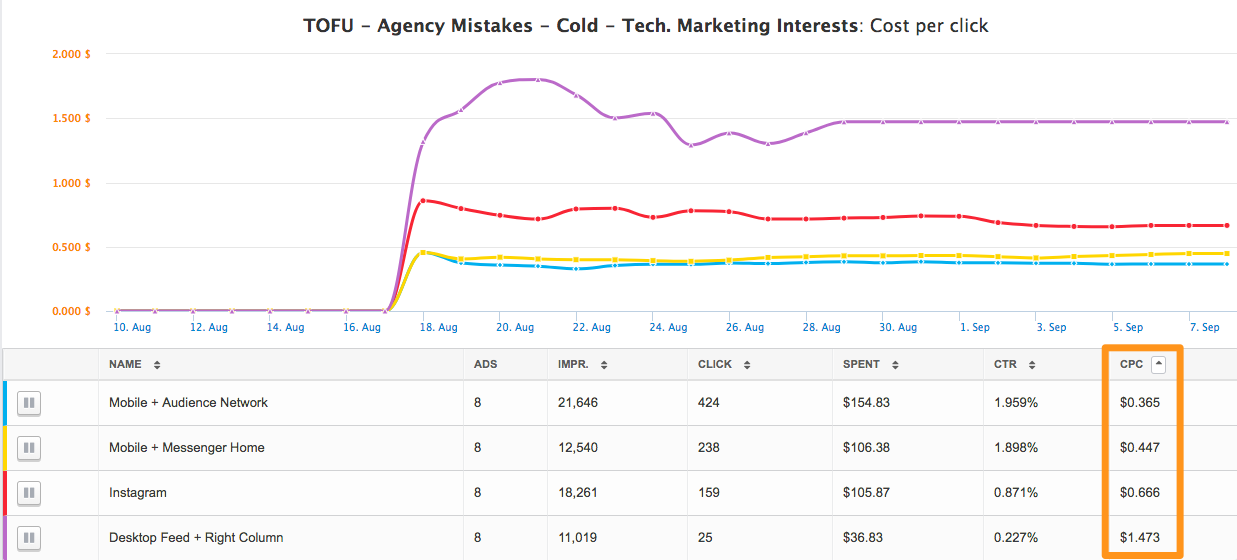
Same exact story.
The Desktop + Right Column option was almost five times more expensive than the Mobile + Audience Network.
Here’s yet another example, different campaign with video creative, where we didn’t even bother with desktop placements.
TOFU/MOFU campaigns expand your funnel. They’re not designed to convert. Therefore, you don’t need to overspend on competitive (and expensive) desktop placements.
Instead, your goal is to build those quality audiences for as cheaply as possible so you can retarget them again and again and again.
And that will almost always be with mobile-based placements.
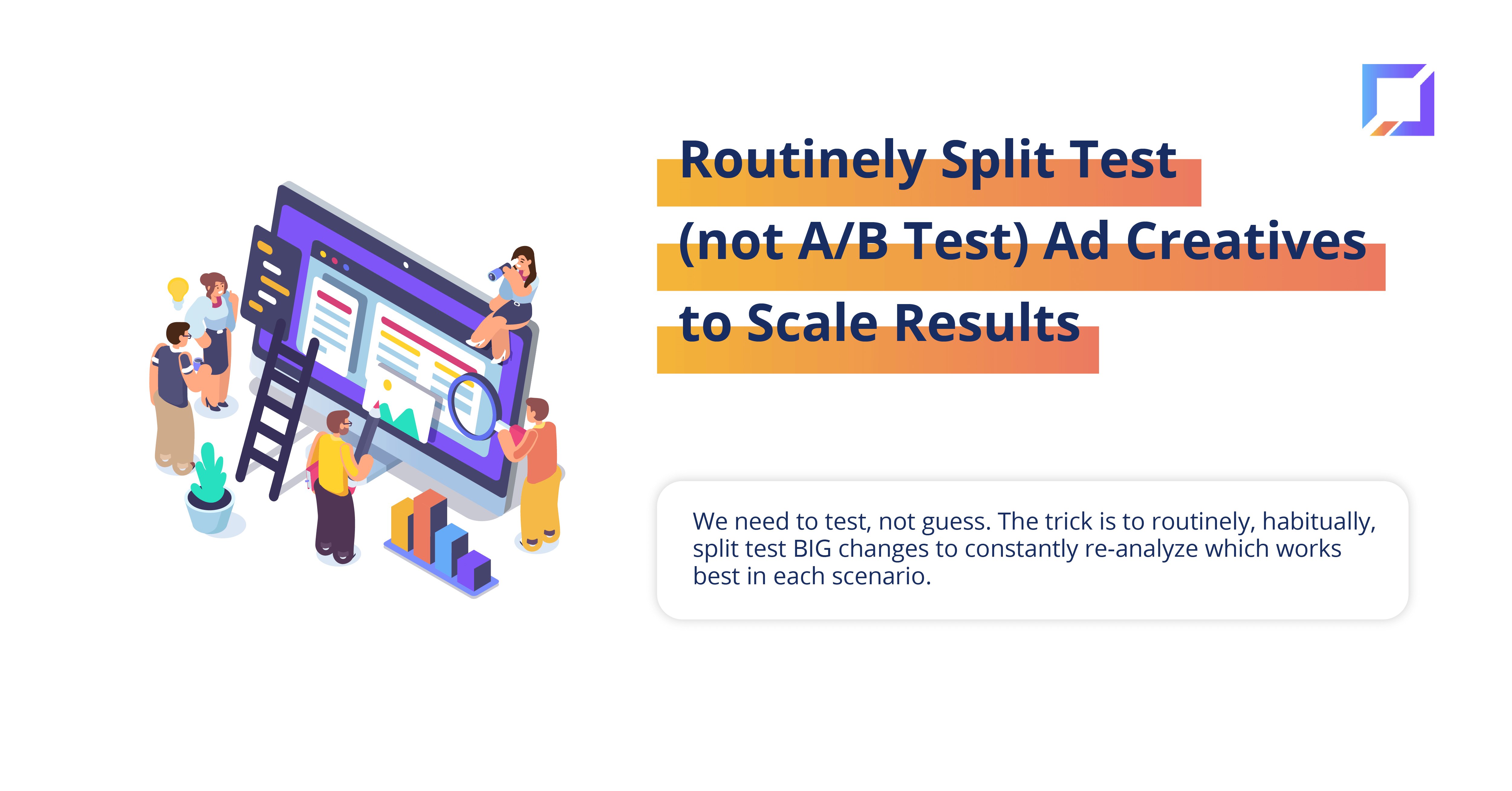
5. Routinely split test (not A/B test) ad creatives to scale results.
Best practices are past practices.
Marketers like to act like we’re geniuses. Like to act like we know what’s going on.
But the truth is a little less assured.
Use cases and verticals and customers and platforms and options change too quickly.
What works for one person in one circumstance is almost guaranteed not to work as well in others.
So by definition, we need to test, not guess.
I’m not talking about inaccurate A/B tests for tiny variables, either. Swapping out one beautiful Hawaiian sunset for another one when promoting your Hawaii vacation site won’t really add up to a significant difference at the end of the day.
Instead, it’s healthier (and more effective) to assume you have no idea what will work and test everything. So you make big changes to actually see big improvements.
For example, we recently introduced some new add-on services for content like custom images and the aforementioned video commercials.
This stuff doesn’t just improve content engagement or time on site (it does). But it also can decrease content promotion costs, too.
To test, I created three ads with:
- Custom image we created
- Featured blog post image (like the one you saw above in #1)
- Video commercial
I *thought* the video one would easily win out. I was wrong in this case.
It performed well with a $0.617 CPC. However, the custom image just edged it out with a $0.439 CPC.
Notice the worst performer in blue?
That’s right:
The standard featured blog post image that almost all companies use when promoting content on social.
Surprise, surprise – the mobile-based placements vastly outperformed the desktop ones, too.

But here’s the thing.
Just because the custom image outperformed the video in one campaign doesn’t mean it always will.
Case in point:
We ran a similar split test on a different campaign with different content, and this time the video came out on top.
Here’s what the two variations looked like:
And here were the results each one fetched:
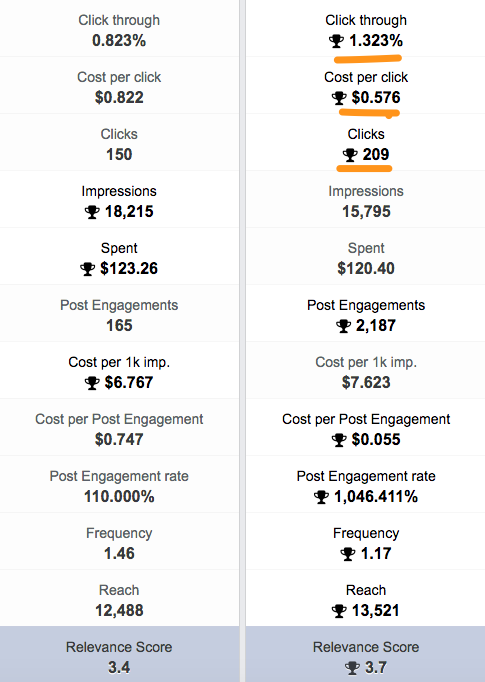
See?
✅ Acting like a genius and sticking with the first ‘best practice’ we saw would only come back to bite us in the ass on future campaigns.
The trick is to routinely, habitually, split test BIG changes to constantly re-analyze which works best in each scenario.
Forget about the CTA. Forget about the description copy. Just keep Grammarly Chrome running and you’re good to go.
You know what the ‘perfect headline’ is?
It’s not the one you slave 10 hours over. It’s the one that outperforms the other 10 you just tried before it.
So stop over-intellectualizing and start re-testing your assumptions with new (big) variables.
Conclusion
Awesome ads come from awesome content.
It’s the glue. It’s the foundation.
It’s any other stupid metaphor that relates to the critical 20% part that dictates the 80% of your results.
After that?
It’s about testing, learning, optimizing, and improving.
Content creation isn’t distribution. It’s only the first step in a very long journey.
But when you combine the two, taking assets from one to leverage the other, you can see a significantly better return over the long haul.
Your promoted content will perform. Not be pathetic. And you’ll get paid.



